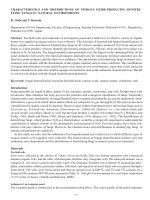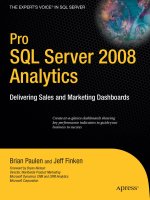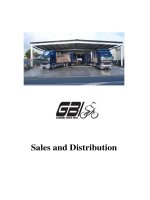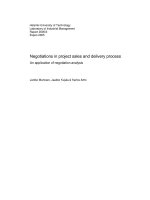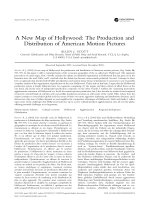SAP ConfigGuide: Sales and Distribution
Bạn đang xem bản rút gọn của tài liệu. Xem và tải ngay bản đầy đủ của tài liệu tại đây (691.98 KB, 232 trang )
EHP3 for SAP ERP
6.0
December 2008
English
Sales and Distribution
(105)
Building Block Configuration Guide
SAP AG
Dietmar-Hopp-Allee 16
69190 Walldorf
Germany
SAP Best Practices
Sales and Distribution (105): Configuration Guide
Copyright
© Copyright 2008 SAP AG. All rights reserved.
No part of this publication may be reproduced or transmitted in any form or for any purpose without the
express permission of SAP AG. The information contained herein may be changed without prior notice.
Some software products marketed by SAP AG and its distributors contain proprietary software components
of other software vendors.
Microsoft, Windows, Excel, Outlook, and PowerPoint are registered trademarks of Microsoft Corporation.
IBM, DB2, DB2 Universal Database, OS/2, Parallel Sysplex, MVS/ESA, AIX, S/390, AS/400, OS/390,
OS/400, iSeries, pSeries, xSeries, zSeries, System i, System i5, System p, System p5, System x, System z,
System z9, z/OS, AFP, Intelligent Miner, WebSphere, Netfinity, Tivoli, Informix, i5/OS, POWER, POWER5,
POWER5+, OpenPower and PowerPC are trademarks or registered trademarks of IBM Corporation.
Adobe, the Adobe logo, Acrobat, PostScript, and Reader are either trademarks or registered trademarks of
Adobe Systems Incorporated in the United States and/or other countries.
Oracle is a registered trademark of Oracle Corporation.
UNIX, X/Open, OSF/1, and Motif are registered trademarks of the Open Group.
Citrix, ICA, Program Neighborhood, MetaFrame, WinFrame, VideoFrame, and MultiWin are trademarks or
registered trademarks of Citrix Systems, Inc.
HTML, XML, XHTML and W3C are trademarks or registered trademarks of W3C®, World Wide Web
Consortium, Massachusetts Institute of Technology.
Java is a registered trademark of Sun Microsystems, Inc.
JavaScript is a registered trademark of Sun Microsystems, Inc., used under license for technology invented
and implemented by Netscape.
SAP, R/3, xApps, xApp, SAP NetWeaver, Dut, PartnerEdge, ByDesign, SAP Business ByDesign, and other
SAP products and services mentioned herein as well as their respective logos are trademarks or registered
trademarks of SAP AG in Germany and in several other countries all over the world. All other product and
service names mentioned are the trademarks of their respective companies. Data contained in this
document serves informational purposes only. National product specifications may vary.
These materials are subject to change without notice. These materials are provided by SAP AG and its
affiliated companies ("SAP Group") for informational purposes only, without representation or warranty of
any kind, and SAP Group shall not be liable for errors or omissions with respect to the materials. The only
warranties for SAP Group products and services are those that are set forth in the express warranty
statements accompanying such products and services, if any. Nothing herein should be construed as
constituting an additional warranty.
© SAP AG
Page 3 of 106
SAP Best Practices
Sales and Distribution (105): Configuration Guide
Icons
Icon
Meaning
Caution
Example
Note
Recommendation
Syntax
External Process
Business Process Alternative/Decision Choice
Typographic Conventions
Type Style
Description
Example text
Words or characters that appear on the screen. These include Field
names, screen titles, pushbuttons as well as menu names, paths and
options.
Cross-references to other documentation.
Example text
Emphasized words or phrases in body text, titles of graphics and tables.
EXAMPLE TEXT
Names of elements in the system. These include report names,
program names, transaction codes, table names, and individual key
words of a programming language, when surrounded by body text, for
example, SELECT and INCLUDE.
Example text
Screen output. This includes file and directory names and their paths,
messages, source code, names of variables and parameters as well as
names of installation, upgrade and database tools.
EXAMPLE TEXT
Keys on the keyboard, for example, function keys (such as
ENTER key.
Example text
Exact user entry. These are words or characters that you enter in the
system exactly as they appear in the documentation.
<Example text>
Variable user entry. Pointed brackets indicate that you replace these
words and characters with appropriate entries.
© SAP AG
F2)
or the
Page 4 of 106
SAP Best Practices
Sales and Distribution (105): Configuration Guide
Contents
Sales and Distribution.........................................................................................................................8
1
Purpose..........................................................................................................................8
2
Preparation.....................................................................................................................8
2.1
3
Prerequisites..................................................................................................................8
Configuration..................................................................................................................8
3.1
3.1.1
3.2
Order Scheduling...........................................................................................................8
Defining Floats (Scheduling Margin Key).....................................................................8
SD Business Partner Configuration..............................................................................9
3.2.1
Customer Control...........................................................................................................9
3.2.2
Customer Master Data................................................................................................15
3.2.3
Customer Hierarchies..................................................................................................16
3.3
Logistics Execution......................................................................................................18
3.3.1
LE: Shipment Cost.......................................................................................................18
3.3.2
LE: Routes...................................................................................................................19
3.3.3
LE: Packaging..............................................................................................................19
3.3.4
LE: Defining Shipping Points.......................................................................................23
3.3.5
LE: Deliveries...............................................................................................................24
3.4
Pricing..........................................................................................................................26
3.4.1
Defining Condition Tables............................................................................................26
3.4.2
Defining Access Sequences........................................................................................27
3.4.3
Condition Types...........................................................................................................27
3.4.4
Copying Rules for Condition Types.............................................................................28
3.4.5
Defining and Assigning Pricing Procedure..................................................................28
3.4.6
Defining Pricing Procedure Determination..................................................................31
3.4.7
Defining Document Pricing Procedure........................................................................32
3.5
Account Determination................................................................................................32
3.5.1
Materials: Account Assignment Group........................................................................32
3.5.2
Customers: Account Assignment Group.....................................................................33
3.5.3
Defining Account Determination Procedure................................................................33
3.5.4
Default Values for Account Group for Customer Creation..........................................34
3.5.5
Defining Account Keys.................................................................................................34
3.6
Assigning G/L Accounts...............................................................................................35
3.7
Tax Determination in Master Records.........................................................................38
3.7.1
© SAP AG
Defining Tax Determination Rules...............................................................................38
Page 5 of 106
SAP Best Practices
3.8
Sales and Distribution (105): Configuration Guide
Availability Check.........................................................................................................38
3.8.1
Defining Checking Groups..........................................................................................38
3.8.2
Defining Material Block for Other Users.....................................................................39
3.8.3
Defining Checking Groups Default Value...................................................................39
3.8.4
Carrying Out Control for Availability Check.................................................................40
3.8.5
Availability Checking against Product Allocation: Maintaining Procedure.................41
3.8.6
Availability Checking against Product Allocation: Defining Object.............................42
3.8.7
Availability Checking against Product Allocation: Specifying Hierarchy....................42
3.8.8
Availability Checking against Product Allocation: Defining Consumption Periods....43
3.8.9
Availability Checking against Product Allocation: Controlling Product Allocation......43
3.8.10
Defining Flow According to Requirement Category....................................................44
3.9
3.9.1
3.10
Output Control..............................................................................................................45
Maintaining Output Determination Procedure............................................................45
Output Control – Sales Documents............................................................................45
3.10.1
Maintaining Output Types: Output Types....................................................................45
3.10.2
Maintaining Output Types: Message Types................................................................46
3.11
Output Control – Shipping...........................................................................................47
3.11.1
Maintaining Output Types............................................................................................47
3.11.2
Maintaining Output Determination Procedure - Procedures......................................47
3.11.3
Maintaining Output Types - Partner Function.............................................................48
3.12
Output Control – Billing................................................................................................49
3.12.1
Maintaining Output Types............................................................................................49
3.12.2
Assigning Output Determination Procedures.............................................................49
3.12.3
SD Output Determination - Billing Partner Functions.................................................50
3.13
Defining Print Parameters...........................................................................................50
3.13.1
Defining Print Parameters Sales Organization...........................................................50
3.13.2
Defining Print Parameters Shipping............................................................................51
3.14
Output Control – Picking SD.......................................................................................52
3.14.1
Output Determination for Picking List.........................................................................52
3.14.2
Maintaining Print Parameter for SD Picking...............................................................53
3.15
Product-Specific Settings............................................................................................53
3.15.1
Maintaining Procedure Determination in Background for Product Proposal.............53
3.15.2
Maintaining Procedure Determination Online for Product Proposal..........................54
3.15.3
Assigning Document Procedure to Sales Document Type........................................54
3.16
Defining Item Category Groups...................................................................................55
3.17
Determining Active Receivables per Item Category...................................................56
3.18
Changing Controllable Error Messages Shipping Processing...................................56
© SAP AG
Page 6 of 106
SAP Best Practices
3.19
Sales and Distribution (105): Configuration Guide
Sales Order Processing I............................................................................................56
3.19.1
Defining Number Ranges for Sales Documents.........................................................57
3.19.2
Defining Sales Document Types.................................................................................57
3.19.3
Sales Organizations - Assign Order Type...................................................................58
3.19.4
Divisions by SalesOrg - Assign Order Type................................................................59
3.19.5
DistribCh by SalesOrg - Assigning Order Type..........................................................59
3.19.6
Assigning Sales Area to Sales Document Types........................................................60
3.19.7
Assigning Sales Area to Credit Control Area..............................................................61
3.19.8
Defining Commodity Codes / Import Code Numbers by Country..............................61
3.19.9
Defining Customs Offices............................................................................................62
3.19.10 Defining Modes of Transport.......................................................................................62
3.19.11 Defining Business Transaction Types and Default Value...........................................63
3.19.12 Proposal for Business Transaction Type in Export.....................................................63
3.19.13 Defining Relevant Item Categories.............................................................................63
3.19.14 Defining Incompleteness Procedures.........................................................................64
3.19.15 Assigning Incompleteness Procedures.......................................................................65
3.19.16 Foreign Trade Data in MM and SD Documents..........................................................65
3.19.17 Defining and Assigning Text Determination Procedures............................................65
3.19.18 Assigning Material Determination Procedures to Sales Document Types................66
3.20
Down Payment Configuration.....................................................................................66
3.20.1
Defining Billing Plan Types..........................................................................................67
3.20.2
Date Category..............................................................................................................67
3.20.3
Defining and Assigning Item Category YBAO............................................................68
3.21
Defining Item Categories for Deliveries......................................................................68
3.22
Assigning Item Categories..........................................................................................69
3.23
Copy Control: Sales Document to Billing Document..................................................70
3.24
Specifying Copy Controls for Deliveries.....................................................................71
3.25
Determination of Requirement Types using Transaction...........................................71
3.26
Defining Delivery Item Category.................................................................................72
3.27
SIS Configuration.........................................................................................................73
3.27.1
SIS Header Configuration...........................................................................................73
3.27.2
SIS Item Configuration................................................................................................73
3.27.3
Activate SIS Info Structures........................................................................................74
3.28
LE Output Control........................................................................................................74
3.28.1
Maintaining Output Determ. Procedures for Outbound Deliveries.............................75
3.28.2
Maintaining Output Determination Procedure for Shipping Units - Control...............75
3.29
© SAP AG
Sales Document Processing II....................................................................................76
Page 7 of 106
SAP Best Practices
Sales and Distribution (105): Configuration Guide
3.29.1
Maintaining Copy Control for Sales Documents (QT) Header...................................76
3.29.2
Maintaining Copy Control for Sales Documents (QT) Item........................................76
3.29.3
Maintaining Copy Control for Sales Documents (QT) Schedule Line........................78
3.29.4
Assigning Item Categories..........................................................................................78
3.29.5
Defining Item Categories.............................................................................................79
3.29.6
Setting up Partner Determination Procedure Assignment for Item categories..........79
3.29.7
Maintaining Item Category Assign Text Determination Procedure.............................80
3.29.8
Assigning Incompleteness Procedures.......................................................................81
3.29.9
Maintaining Copy Control Delivery Doc. to Billing Doc..............................................81
4
Creating Master Data..................................................................................................82
4.1
5
© SAP AG
Creating Output Tax Record (MWST).........................................................................82
Appendix......................................................................................................................83
Page 8 of 106
SAP Best Practices
Sales and Distribution (105): Configuration Guide
Sales and Distribution
1 Purpose
This configuration guide provides the information you need to set up the configuration of this
building block manually.
If you do not want to configure manually and prefer an automated installation process using the
SAP Best Practices Installation Assistant and other tools, refer to the SAP Best Practices Quick
Guide.
2 Preparation
2.1 Prerequisites
Before you start installing this scenario, you must install prerequisite building blocks. For more
information, see the Building Block Prerequisites Matrix for SAP Best Practices Baseline
Package.
3 Configuration
3.1 Order Scheduling
3.1.1
Defining Floats (Scheduling Margin Key)
Use
The purpose of this step is to define the scheduling margin key.
Procedure
1. Access the activity using one of the following navigation options:
Transaction code
SPRO
IMG menu
ProductionShop Floor ControlOperationsSchedulingDefine
Scheduling Margin Key
2. On the Change View Margins for scheduling: Overview screen, choose New Entries.
3. On the New Entries: Details of Added Entries screen, make the following entries:
Plnt
Name 1
Key
Opening
Period
Float After
Production
Float Before
Production
Release
Period
1000
Plant 1
000
000
000
000
000
1000
Plant 1
001
010
001
002
005
1100
Plant 2
000
000
000
000
000
1100
Plant 2
001
010
001
002
005
© SAP AG
Page 9 of 106
SAP Best Practices
Sales and Distribution (105): Configuration Guide
4. Choose Save.
3.2 SD Business Partner Configuration
3.2.1
Customer Control
3.2.1.1 Setting up Partner Determination: Account Groups Function Assignment
Use
In this activity, you define the rules that should be used to perform automatic partner
determination.
Procedure
1. Access the activity using one of the following navigation options:
Transaction code
SM34
IMG menu
Sales and DistributionBasic FunctionsPartner
DeterminationSet up Partner Determination
© SAP AG
Page 10 of 106
SAP Best Practices
Sales and Distribution (105): Configuration Guide
2. In the Choose Activity dialog box, double-click Set up Partner Determination for
Customer Master.
3. On the Change View Partner Determination Procedures: Overview screen, double-click
Account Groups – Function Assignment.
4. Choose New Entries.
5. On the New Entries: Details of Added Entries screen, make the following entries:
© SAP AG
Page 11 of 106
SAP Best Practices
Sales and Distribution (105): Configuration Guide
Partn.Funct.
Account Group
1B
YB01
1C
YB01
1D
YB01
1D
0003
AA
YB01
SP
YB01
AW
YB01
BP
YB01
BP
0003
PY
YB01
PY
0003
SB
YB01
SO
YB01
SH
YB01
SH
YBVC
SP
YBEC
BP
YBEC
PY
YBEC
SH
YBEC
SP
YBAC
BP
YBAC
PY
YBAC
SH
YBAC
SP
YBPC
BP
YBPC
PY
YBPC
SH
YBPC
1B
YB03
1C
YB03
1D
YB03
AA
YB03
SP
YB03
AW
YB03
BP
YB03
PY
YB03
© SAP AG
Page 12 of 106
SAP Best Practices
Sales and Distribution (105): Configuration Guide
SB
YB03
SO
YB03
SH
YB03
6. Choose Save.
3.2.1.2 Defining Customer Account Group for DUMMY Customer
Use
This activity defines the customer account group for the DUMMY customer.
Procedure
1. Access the activity using one of the following navigation options:
Transaction code
OVT0
IMG menu
Logistics – GeneralBusiness PartnerCustomersControl
Define Account Groups and Field Selection for Customers
2. On the Change View Customer Account Groups: Overview screen, choose New
Entries.
3. On the New Entries: Details of Added Entries screen, make the following entries:
Field name
Description
User action and values
Account group
YBPC Dummy customer
Number range
XX
Note
CentrTextDetPrc
TextDetProc SD
Cust.pric.proc.
PartnDet.Proc.
AG
Default SP
Checked
© SAP AG
Page 13 of 106
SAP Best Practices
Sales and Distribution (105): Configuration Guide
4. Double-click the General data text.
5. On the Maintain Field Status Group: Overview screen, set the radio buttons in each group as
follows:
© SAP AG
Page 14 of 106
SAP Best Practices
Field name
Sales and Distribution (105): Configuration Guide
User action and values
Group Address
Suppress
Search term B, Street 5, Buildings, Company postal code, Note, Regional
structure grouping, Sex, Date of birth, Marital status, Academic title, Name
prefix, 2. academic title, 2nd prefix, Name at Birth, Nickname, Name affix,
Initials, Country for format, Format name, Alternative place of residence,
P.O. box without number, PO box country, PO Box Region, Name
Formatting, Undeliverable Street, Undeliverable Postbox
Req. Entry
Name 1/last name, Search term A, Postal code, city,
Opt. Entry
Mark the rest optional
Display
N/A
Group Communication
Suppress
Mobile Telephone
Req. Entry
N/A
Opt. Entry
Mark the rest optional
Display
N/A
Group Control
Suppress
Reference account group (OTA), Business Place, Tax type, CFOP
category, Tax number 3, Tax number 4, Brazilian taxes: ICMS, IPI, S.T.,
Tax categories
Req. Entry
N/A
Opt. Entry
Mark the rest optional
Display
N/A
Group Marketing
Suppress
N/A
Req. Entry
N/A
Opt. Entry
Mark all optional
Display
N/A
Group Payment transactions
Suppress
N/A
Req. Entry
N/A
Opt. Entry
Mark all optional
Display
N/A
Group Unloading points
Suppress
N/A
Req. Entry
N/A
Opt. Entry
Mark all optional
Display
N/A
© SAP AG
Page 15 of 106
SAP Best Practices
Sales and Distribution (105): Configuration Guide
Group Contact person
Suppress
N/A
Req. Entry
N/A
Opt. Entry
Mark all optional
Display
N/A
Group Foreign trade
Suppress
N/A
Req. Entry
N/A
Opt. Entry
Mark all optional
Display
N/A
© SAP AG
Page 16 of 106
SAP Best Practices
Sales and Distribution (105): Configuration Guide
6. Choose Save, and then choose Back.
7. Double-click the Company code data text,.
8. On the Maintain Field Status Group: Overview screen, set the radio buttons in each group as
follows:
Field name
User action and values
Group Account management
Suppress
Personnel number, Gross income tax, Value adjustment key
Req. Entry
N/A
Opt. Entry
Mark the rest optional
Display
N/A
Group Payment transactions
Suppress
Credit memo terms of payment, Diff. Payer in document, Accts recble
pledging ind.
Req. Entry
N/A
Opt. Entry
Mark the rest optional
Display
N/A
Group Correspondence
Suppress
N/A
Req. Entry
N/A
Opt. Entry
Mark all optional
Display
N/A
Group Insurance
Suppress
N/A
Req. Entry
N/A
Opt. Entry
Mark all optional
Display
N/A
Group W/holding tax data, w/h tax 2
Suppress
Withholding tax code (2), Withholding tax number, Withholding tax types
Req. Entry
N/A
Opt. Entry
W/hold.tax deduction, w/h tax 2
Display
N/A
© SAP AG
Page 17 of 106
SAP Best Practices
Sales and Distribution (105): Configuration Guide
9. Choose Save, and then choose Back.
10. Double-click the Sales data text.
11. On the Maintain Field Status Group: Overview screen, set the radio buttons in each group as
follows:
Field name
User action and values
Group Sales
Suppress
N/A
Req. Entry
Pricing procedure, Currency
Opt. Entry
Mark the rest optional
Display
N/A
Group Shipping
Suppress
Rail specifications
Req. Entry
N/A
Opt. Entry
Mark the rest optional
Display
N/A
Group Billing
Suppress
Hedging and credit contr. Area
Req. Entry
Taxes and licenses
Opt. Entry
Mark the rest optional
Display
N/A
Group Partner usage
Suppress
N/A
Req. Entry
N/A
Opt. Entry
Mark all optional
Display
N/A
Group Documents
Suppress
N/A
Req. Entry
N/A
Opt. Entry
Mark all optional
Display
N/A
© SAP AG
Page 18 of 106
SAP Best Practices
Sales and Distribution (105): Configuration Guide
12. Choose Save.
3.2.1.3 Partner Determination Procedure Assignment
Use
This activity assigns the account groups to the partner determination procedure.
Procedure
1. Access the activity using one of the following navigation options:
Transaction code
SM34
IMG menu
Sales and DistributionMaster DataBusiness Partners
CustomersCustomer HierarchySet Partner Determination for
Hierarchy Categories
2. In the Choose Activity dialog box, double-click Set up Partner Determination for
Customer Master.
3. On the Change View Partner Determination Procedures: Overview screen, double-click
Partner Determination Procedure Assignment.
4. On the Change View Partner Determination Procedure Assignment: Overview screen, make
the following entries:
Group
Description
Partner Determination
Procedure
Name
YB01
Sold-to party
AG
Sold-To Party
YB02
Customer (ext.number
assignment)
AG
Sold-To Party
YB03
Sold-to party Demo
(int.Numb.)
AG
Sold-To Party
YBAC
Affiliated Companies - BP
AG
Sold-To Party
YBEC
Export Customers - BP
AG
Sold-To Party
YBOC
One-time cust.
(ext.no.assgnmt)
AG
Sold-To Party
YBPC
Dummy customer
AG
Sold-To Party
YBVC
Vendor_AT
WE
ship-to party
© SAP AG
Page 19 of 106
SAP Best Practices
Sales and Distribution (105): Configuration Guide
5. Choose Save.
3.2.2
Customer Master Data
3.2.2.1 Defining Legal Statuses
Use
This activity defines the possible business forms, which a customer can have (for example,
corporation or limited liability Company). You specify the business form in the general data of the
customer master record as part of the marketing information (which specifies a business form for
all sales areas).
Procedure
1. Access the activity using one of the following navigation options:
Transaction code
OVR6
IMG menu
Sales and DistributionMaster DataBusiness Partners
CustomersMarketingDefine Legal Statuses
2. On the Change View Legal Status (Customer Master): Overview screen, choose New
Entries.
3. On the New Entries: Overview of Added Entries screen, make the following entries:
Legal Status
Description
06
Ltd
07
Inc
08
Jv
10
Corp
4. Choose Save.
3.2.2.2 Defining Customer Groups
Use
In this menu option, you define the customer groups to which a customer can belong. You specify
the customer group for sales data in the customer master record for each sales area. The SAP
system copies this specification automatically into the sales documents at header and item level.
Here, you find the customer group on the detail screen for general business data.
Procedure
1. Access the activity using one of the following navigation options:
Transaction code
OVS9
IMG menu
Sales and DistributionMaster DataBusiness
PartnersCustomersSalesDefine Customer Groups
© SAP AG
Page 20 of 106
SAP Best Practices
Sales and Distribution (105): Configuration Guide
2. On the Change View Customer groups: Overview screen, choose New Entries.
3. On the New Entries: Overview of Added Entries screen, make the following entries:
Cgrp
Name
02
Retail
03
Wholly-owned subsid.
04
Partly owned subsid.
05
Competition
06
Public sector
07
Private customer
08
Wholesale
4. Choose Save.
3.2.2.3 Defining Sales Districts
Use
In this menu option, you define the sales districts in which the customers' subsidiaries can be
located. You specify the sales districts for the sales data in the customer master record for each
sales area.
Procedure
1. Access the activity using one of the following navigation options:
Transaction code
OVR0
IMG menu
Sales and DistributionMaster DataBusiness
PartnersCustomersSalesDefine Sales Districts
2. On the Change View Customers: Sales Districts: Overview screen, choose New
Entries.
3. On the New Entries: Overview of Added Entries screen, make the following entries:
Sales district
District name
ACT
Capital
QLD
Center area
SA
South Area
TAS
North Area
VIC
Eastern Area
WA
Western Area
© SAP AG
Page 21 of 106
SAP Best Practices
Sales and Distribution (105): Configuration Guide
4. Choose Save
3.2.3
Customer Hierarchies
3.2.3.1 Assigning Sales Areas to Customer Hierarchy Types
Use
This activity assigns sales areas to each other, which allows you to determine whether a sales
area uses its own customer hierarchies or shares one with another sales area.
Procedure
1. Access the activity using one of the following navigation options:
Transaction code
OVH3
IMG menu
Sales and DistributionMaster DataBusiness Partners
CustomersCustomer HierarchyAssign Sales Areas
2. On the Change View Customer Hierarchy: Allowed Sales Area Assignments: Over
screen, choose New Entries.
3. On the New Entries: Overview of Added Entries screen, make the following entries.
CustHType
Sales Org.
Distr.Chl
Division
HgLvSlsOrg
HLDstrCh
HgLvDivis.
A
1000
10
10
1000
10
10
4. Choose Save.
3.2.3.2 Allowed Account Group Assignments for Customer
Hierarchies
Use
This activity assigns the possible high-level account groups to the account groups permitted for
each customer hierarchy type. Therefore, both the valid account groups for each hierarchy type
are defined and the high-level account groups of the valid account groups. This prevents the
system assigning a ship-to party above a sold-to party.
Procedure
1. Access the activity using one of the following navigation options:
Transaction code
OVH2
IMG menu
Sales and DistributionMaster DataBusiness Partners
CustomersCustomer HierarchyAssign Account Groups
© SAP AG
Page 22 of 106
SAP Best Practices
Sales and Distribution (105): Configuration Guide
2. On the Change View Allowed Acct. Grp. Assign. for Cust. Hier.: Overview screen,
choose New Entries.
3. On the New Entries: Overview of Added Entries screen, make the following entries:
CustHType
Acct Group
Hg Lv Acct Gr
A
YB01
YB01
A
YB01
0003
A
YB01
YB02
A
YB01
0012
A
0012
0012
A
0012
0003
A
0003
0003
A
0003
0012
A
YB02
YB01
A
YB02
0012
A
YB02
0003
A
YB02
YB02
4. Choose Save.
3.3 Logistics Execution
3.3.1
LE: Shipment Cost
3.3.1.1 Defining and Assigning Shipping Type Procedure Group
Use
This activity defines and assigns the shipping type procedure group 0005.
Procedure
1. Access the activity using one of the following navigation options:
Transaction code
T_72
IMG menu
Logistics ExecutionTransportationShipment Costs
PricingPricing ControlDefine and Assign Pricing Procedures
© SAP AG
Page 23 of 106
SAP Best Practices
Sales and Distribution (105): Configuration Guide
2. In the Choose Activity dialog box, double-click Define and assign shipping type
procedure group.
3. On the Change View Define shipping type procedure group: Overview screen, choose New
Entries.
4. On the New Entries: Details of Added Entries screen, make the following entries:
Field name
Description
User action and values
ShpTyp Grp
0005
Description
Air
Note
5. Choose Save, and then choose Back.
6. Double-click Dialog Structure Assign shipping type procedure group.
7. In the 05 Airplane row, in the ShpTyp Grp row, enter 0005.
8. Choose Save.
3.3.1.2 Assigning Purchasing Data
Use
For settlement, you must assign the organizational units in the shipment to the relevant
organizational units in purchasing. These settings are necessary for creating accruals. The
accruals are posted using service entry sheets. The purchasing organizational units are needed
for service procurement.
Procedure
1. Access the activity using one of the following navigation options:
Transaction code
SM30
IMG menu
Logistics ExecutionTransportationShipment Costs
SettlementAssign Purchasing Data
2. On the Change View Assignment of Purchasing Data for Shipment Costs: Overview screen,
choose New Entries.
3. On the New Entries: Details of Added Entries screen, make the following entries:
TPPt
SCTy
POrg
PGr
Plant
1000
0001
1000
100
1000
© SAP AG
Page 24 of 106
SAP Best Practices
Sales and Distribution (105): Configuration Guide
4. Choose Save.
3.3.2
LE: Routes
3.3.2.1 Defining Shipping Types
Use
In this activity, you define the shipping types in combination with the mode of transport.
Procedure
1. Access the activity using one of the following navigation options:
Transaction code
SM30 (Customizing Object V_T173_COM)
IMG menu
Sales and DistributionBasic FunctionsRoutesDefine
RoutesDefine Shipping Types
2. On the Change View Shipping types: Overview screen, choose New Entries.
3. On the New Entries: Details of Added Entries screen, make the following entries:
PT
Description
MdTr
StPG
05
Airplane
05
0005
4. Choose Save.
3.3.3
LE: Packaging
3.3.3.1 Defining Packaging Material Types
Use
The packaging material type combines packaging materials into groups and contains essential
control features, which apply to the corresponding shipping materials. When you specify a
shipping material type in the material master record, each shipping material is assigned to a
shipping material type.
Procedure
1. Access the activity using one of the following navigation options:
Transaction code
VHAR
IMG menu
Logistics – GeneralHandling Unit ManagementBasicsDefine
Packaging Material Types
© SAP AG
Page 25 of 106

